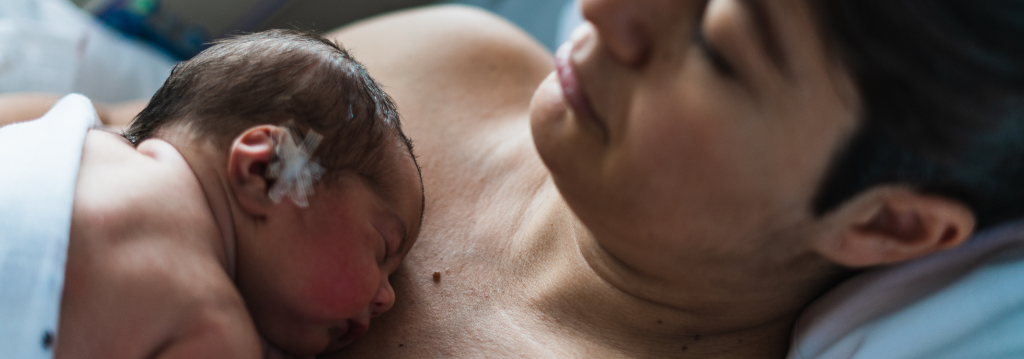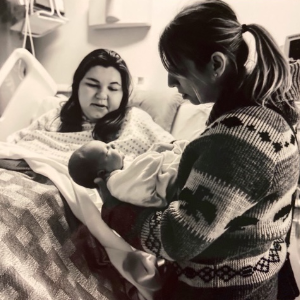
The process of pregnancy and birth is truly fascinating. The body has a finely tuned, well-organized intricate system that initiates and drives labour and on through birth and later breastfeeding. These processes help to develop a deep connection and attachment with their infant, following the birth.
At no other time in one’s life is the hormonal fluctuation as extreme as it is throughout pregnancy. Each hormonal system has a biological process that begins with pregnancy and continues through postpartum and the newborn period. Each system has distinct tasks throughout this journey. Hormones like estrogen, progesterone, and others influence changes in function and brain structures during pregnancy.
There are four distinct hormonal systems at work; oxytocin; beta-endorphins; epinephrine- norepinephrine (adrenaline- noradrenaline) related stress hormone systems; and prolactin.
Oxytocin
Oxytocin is a powerful reproductive hormone that has many effects on the brain and body. It works with the parasympathetic nervous system to invoke calmness, connection, healing, and growth. It helps to produce uterine contractions and creates a calming analgesic effect on both parent and baby throughout labour and postpartum. It also aids in maternal adaptations in the postpartum period that reduce stress, increase sociability, and prime reward centers, imprinting pleasure with infant contact and care, therefore promoting longer-term infant survival. [1]
Beta-endorphins
Beta-endorphins are endogenous opioids that give analgesic and adaptive responses to stress and pain. [2] They are responsible for activating the pleasure centers. They aid in creating an altered state of consciousness to help ease discomfort and overwhelming emotions/tasks/events. They facilitate parental euphoria and imprint pleasure with their newborn. It works with oxytocin together to prime the reward centers for psychological well-being.
Adrenaline
The nervous system is complex and helps regulate the body’s physiology particularly, the interaction between its two branches—the sympathetic nervous system and the parasympathetic nervous system. [4] It also impacts how one copes and manages the birthing sensations, which depends on whether they are in a parasympathetic nervous system state (calm and composed) or a sympathetic state which prepares the body for a fight, flight, or freeze response. The adrenaline system Epinephrine (adrenaline) and norepinephrine (noradrenaline) mediate the system and its response. One’s emotional state impacts the flow of these hormones and how the body responds.
Prolactin
Prolactin is a stress and growth hormone made by the pituitary gland. It begins by communicating to the breast to start breast milk production and the flow of oxytocin to help the connection to the infant. As birth nears, levels peak and rise in conjunction with beta-endorphins and oxytocin.
There are many ways to encourage natural hormonal production during the birth process; here are a few suggestions that can be incorporated into the birthing journey.
- A walk in nature
- Soothing music
- Massage and light touch
- Hydrotherapy (a warm shower, relaxing bathing, or a float session)
Birth hormones are the messengers that the body and infant make. They work together to guide important changes in the body, to help make birth go smoothly and safely. Hormones guide the human body in various ways, such as starting the process of birth and labour, preparing the infant for life outside of the womb, launching breastmilk production, and ensuring oxytocin is working smoothly.
Understanding how hormones work through the birth process can help us better serve our clients to create an environment that facilitates a calm response, enriching their birthing experience.
Source
- Wnuk, Alexis. “How Pregnancy Changes the Brain.” Retrieved from https://www.brainfacts.org/Brain-Anatomy-and-Function/Body-Systems/2018/How-Pregnancy-Changes-the-Brain-022818
- Buckley, Sarah, MB, ChB. “Executive summary of hormonal physiology of childbearing evidence and implications for women.” Retrieved from https://pubmed.ncbi.nlm.nih.gov/26834435/
- Childbirth Connections. “The Role of Hormones in Childbirth.” Retrieved from http://www.childbirthconnection.org/maternity-care/role-of-hormones/
- Goldstein, 2006; Bonaz et al., 2021; “A Review on the Vagus Nerve and Autonomic Nervous System During Fetal Development: Searching for Critical Windows.” Retrieved from https://www.frontiersin.org/articles/10.3389/fnins.2021.721605/full
About the Author

Sonya Duffee’s (CLD, CLDT, CPD, CCCE) journey towards supporting and empowering families through birth began shortly after the birth of her own children. With more than 20 years experience in a variety of birth settings including home births, hospital and birth center providing prenatal, birth and postnatal care to expectant families in the community. Sonya Duffee has attended over 1000 births in Saskatchewan, Alberta, New Mexico, Texas and Colorado providing personalized, individualized care to meet the needs of her clients. From 2002 to 2007 she was the only community based Midwife in Regina, Saskatchewan providing home birth services. Sonya has held many positions in local, provincial and national organizations. Past appointed member of the Saskatchewan College of Midwives and various working committees for the implementation of regulated midwifery. Past President and active member of the Doulas of Regina Association as well past-advisor for the Canadian Doula Association and her involvement in the birthing community through CAPSAC, Birth Unlimited, Friends of the Midwives and the Midwifery Association of Saskatchewan. She was Director of a community based organization called The Family Room in Saskatchewan and contributed to the production of birth related publications such as BEARTH and BIRTHING Magazine.